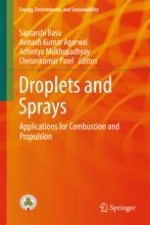2018 | OriginalPaper | Chapter
7. Modeling of Flash Boiling Phenomenon in Internal and Near-Nozzle Flow of Fuel Injectors
Authors : Kaushik Saha, Michele Battistoni, Sibendu Som
Published in: Droplets and Sprays
Publisher: Springer Singapore
Activate our intelligent search to find suitable subject content or patents.
Select sections of text to find matching patents with Artificial Intelligence. powered by
Select sections of text to find additional relevant content using AI-assisted search. powered by
